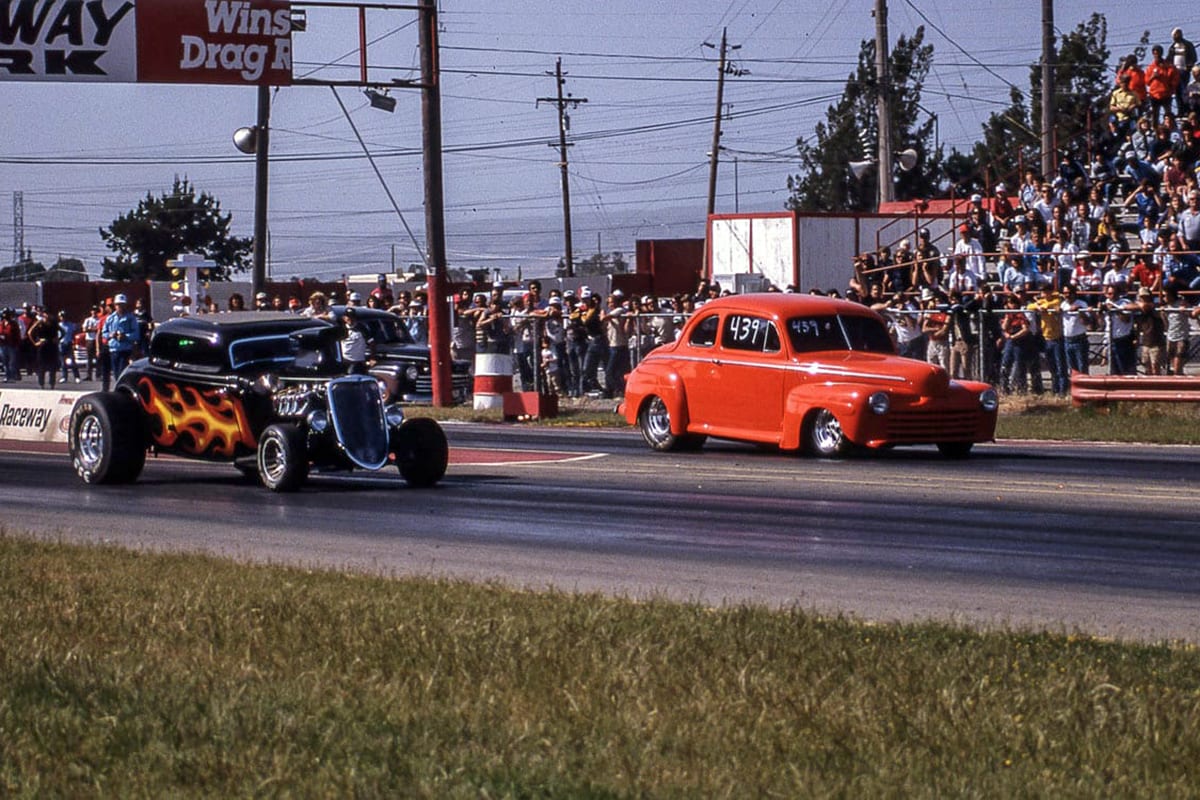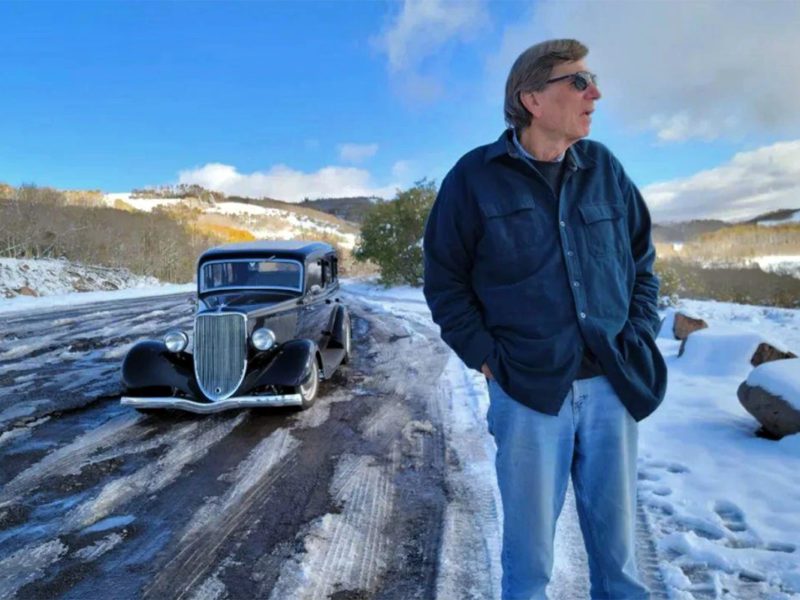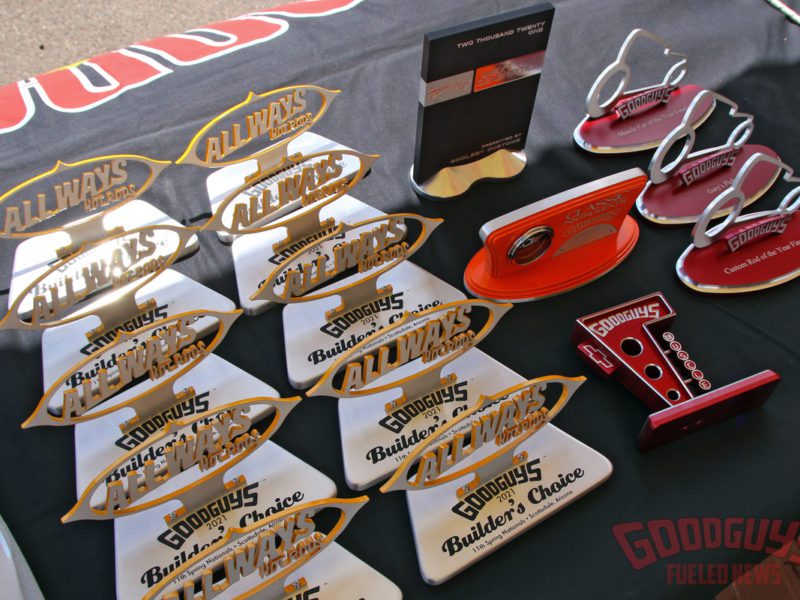Retro Rumblings – Fat Attack!
Above – Cole Cutler’s flamed, Boss 429-powered ’34 coupe squares off against Fat Jack Robinson’s ’46 Ford coupe at Fremont’s Ballads Raceway.
When the 1980s dawned, street rodding was moving toward a renaissance that would have been unthinkable just a few short years prior. Prewar resto rods had been trending for a decade and you could argue the scene had gone somewhat stagnant. Early hot rods were about to give way to their chubby-fendered successors.
The fat-fender craze began simmering in the early-’80s but ignited to a flaming boil when Fat Jack Robinson’s blown, bright orange ’46 Ford coupe landed on the cover of Hot Rod Magazine alongside Pete Chapouirs’ flamed purple ’39 Ford convertible. The July 1985 “Fat Attack” issue ushered in a new era of street cars. As the late Gray Baskerville pointed out in his cover story, there was a “bountiful supply of these postwar castoffs which were both available and affordable.”
And let’s face it, because cover boys Fat Jack and Pete & Jake were doing it, it had an impact – fast tracking the fat and fabulous era of street rodding nationwide.
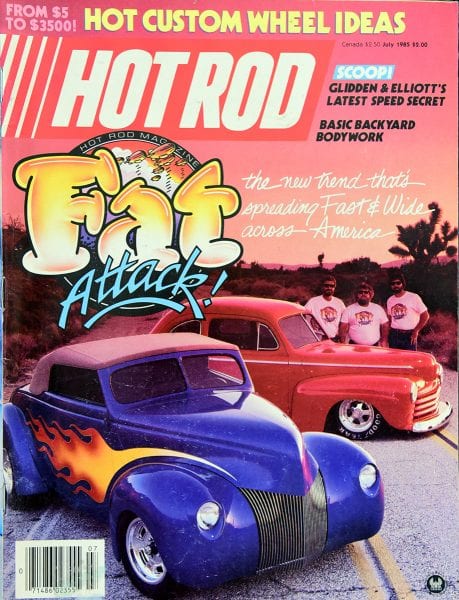 Taking it one step further, these specific cover cars were born to run. Run on the drag strip, that is. When Tom Prufer and his friend Brian Burnett formed the NDRA to promote vintage drags (the precursor to our Goodguys VRA series) they formed a class they called “Super Street” – aka the Fastest Street Rod Wars. It was open to ’48-and-earlier rods in heads-up, fastest-guy-wins competition. These were good old fashioned 1320 shootouts featuring street-legal rods that were not only fast, they were loud and unpredictable. It was not uncommon to see thousands of fans packed into the long-defunct Badlands Raceway in Fremont, California, to cheer on these fleshy Fords and other vintage dragsters, Gassers and roadsters. Fremont was the anchor facility for the series.
Taking it one step further, these specific cover cars were born to run. Run on the drag strip, that is. When Tom Prufer and his friend Brian Burnett formed the NDRA to promote vintage drags (the precursor to our Goodguys VRA series) they formed a class they called “Super Street” – aka the Fastest Street Rod Wars. It was open to ’48-and-earlier rods in heads-up, fastest-guy-wins competition. These were good old fashioned 1320 shootouts featuring street-legal rods that were not only fast, they were loud and unpredictable. It was not uncommon to see thousands of fans packed into the long-defunct Badlands Raceway in Fremont, California, to cheer on these fleshy Fords and other vintage dragsters, Gassers and roadsters. Fremont was the anchor facility for the series.
The promotion and hype in the magazines around the Super Street class was as exciting as the on-track performances. It had overtones of the Cam Wars of the ’50s and ’60s. Readers ate it up.
The combatants in the street rod wars were consistent. It was Fat Jack with his ’46 Ford coupe, a blown and injected, alcohol-huffing behemoth; Cole Cutler’s wicked ’34 Ford Boss 429-powered coupe; Pete & Jake’s 450hp mouse-motored ’39 ’vert; and Jerry Moreland’s “Project ’40” – a wicked black and blown ’40 Tudor. Oregon’s Paul Comeau and his wheel-standing ’39 Chevy four-door were also in the class, as were two ’34 coupes out of Sacramento, one of which was Guy Ruchonnet’s blown Chrysler entry.

For a time, Jerry Moreland’s ’40 Ford Tudor was the World’s Fastest Street Rod. Not only that, the car was a looker. Bob Bauder and Tom Vogele built this beast.
In subsequent years, Mendy and Roy Fry’s ’27 Ford street roadster, Steve Castelli’s bright yellow “Hot Rod Willys,” Ray Castor’s ’39 Chevy, and Maryann Harmon’s Willys also joined the Super Street party.
While nostalgia drag racing was fairly unorganized at the time and the events primarily featured “grudge matches,” the Super Street class offered prestige and national bragging rights. No purse money was offered, just wall plaques and trophies.
As the class progressed, the performances were nothing to sneeze at, with Moreland’s ’40 Tudor logging low-9-second quarter-mile ETs at speeds approaching 150mph. We spoke to Fat Jack’s son John Robinson who also remembers their ’46 dipping into the 9s. For Robinson, a teenager at the time, the scene was a thrilling way to spend nights and weekends away from school.
“In high school, I helped dad build the orange ’46,” John reflected “We took it to Fremont in ’85 and had fun with a carbureted engine, but it needed more power. Plus, we went through so many Powerglide transmissions, eventually we were forced to put a Lenco in the car. It solved the transmission problem and allowed us to put in the blown alky motor that George Streigel had in his boat.”
Hearing Robinson’s voice, you could tell how fond the memories were in the early days of vintage drag racing. “The week before we ran the car for the first time, I got to stay home from school the entire week,” he said. “We thrashed so hard. It was what it was – my dad needed cheap labor,” he laughed.
Things accelerated in Super Street the next few years and like it always does (at least on the dragstrip), things got out of hand. Driving Fat ’46 at the Fremont spring meet in 1988, pilot Dave Condit hit high gear around half track and the car turned right. It slid through the grass, hooked a wheel and went tumbling over and over. The whole car was destroyed. Jack vowed to come back with a wicked-looking ’46 delivery but the car never made it on to the track.
In 1989, our Goodguys team held the Jim Davis Memorial/Brent Davis Benefit race – the first full-blown Goodguys vintage drag race. A few surviving Super Streeters came to play, but things were changing. Eventually, the cars got put into the Goodguys Hot Rod class and still ran 8- and 9-second elapsed times in staggered-start handicap racing.
Around 1992, Goodguys offered a touring match race gig to Ray Castor and Steve Castelli to stage their own private Fastest Street Rod war, both machines frequently running in the mid- to high-8s. It served as great promotional material for the early years of Goodguys VRA racing as well as some juicy storylines for the Gazette. They raced as far away as Reading, Pennsylvania. Castelli usually came out on top. To this day, Steve Castelli holds the title of World’s Fastest Street Rod. Using Flowmaster Mufflers, he ran 8.06 at 170mph.
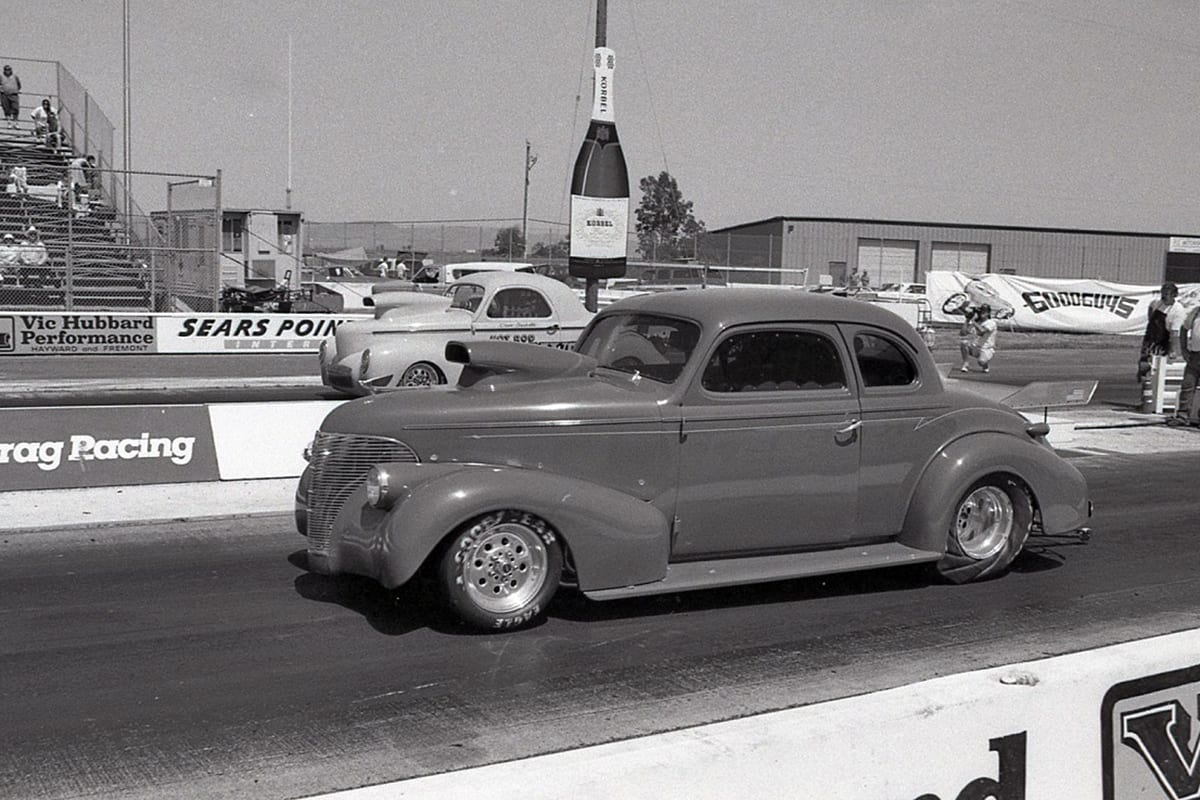
Ray Castor’s ’39 Chevy coupe and Steve Castelli’s Hot Rod Willys toured the country with Goodguys in 1992 in what was called the “World’s Fastest Street Rod Shootout.”
Thanks to the Fat Attack era, chubby fender street rods thrived for a good long while occupying a hefty chunk of our hot rod history. These cars indeed proved that FAT was fabulous.

